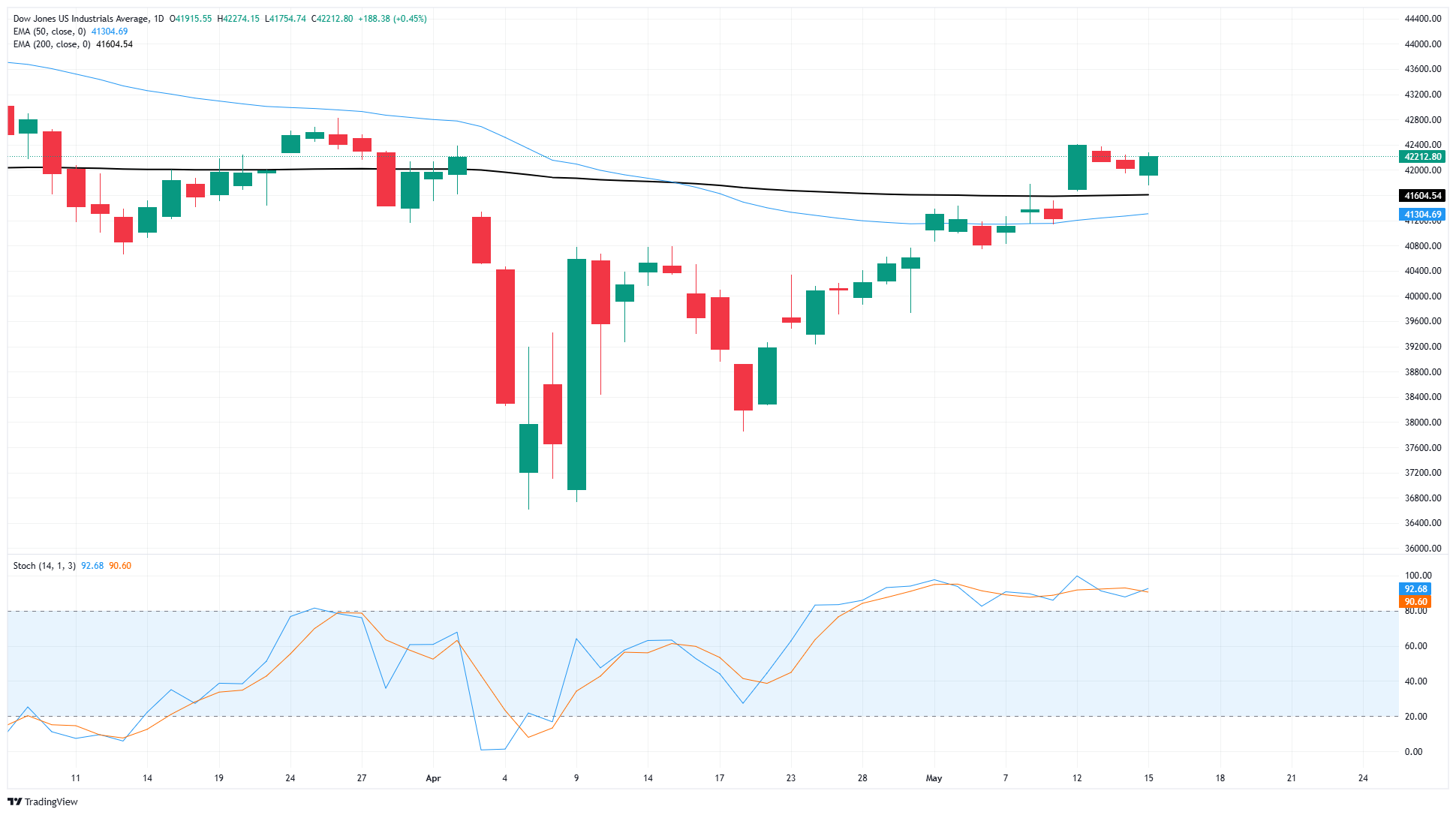Dow Jones gains ground as PPI beat boosts investor confidence
- The Dow Jones climbed around 200 points on Thursday as sentiment continues to improve.
- US PPI inflation eased faster than expected in April, but future risks remain.
- UoM sentiment survey results are in the barrel for Friday.
The Dow Jones Industrial Average (DJIA) pared early-week losses and rose about 200 points on Thursday. Equities were bolstered by a better-than-expected Producer Price Index (PPI) inflation print that showed upstream inflation effects are still cooling at a faster rate than initially expected. While tariff-based risks to both employment and inflation remain an ongoing concern, investors remain hopeful that early trade talks between the United States (US) and China will continue to develop into meaningful, more permanent suspensions of high tariffs going in both directions.
US PPI inflation chilled more than expected in April, with business-level inflation contracting 0.5% MoM. Core PPI inflation in April also fell 0.4%, with annualized core business inflation easing to 2.4% YoY from the previous period’s 2.7%. With both CPI and PPI measures for April giving better-than-expected inflation prints this week, investors are allowing themselves the room to hope that ongoing trade talks between the US and China will avert the worst of potential tariff damage.
The Trump administration pulled the tariff gun away from its own head last weekend when it temporarily suspended its own 145% tariffs on all Chinese goods, causing the Chinese government to do the same and rescind its own triple-digit tariffs. The tariff suspension is only slated to last 90 days, giving investors room to breathe but not enough to relax entirely.
Cooling inflation puts investors in a buying mood, but risks remain
Equity markets are expected to continue to find reasons to buy for now, but a slate of possible headwinds still lurk ahead. Even with the Trump administration’s 90-day tariff reprieve, import taxes on nearly all goods bound for the US remain far higher than in recent history. According to estimates by Fitch Ratings, the US’s Effective Tariff Rate (ETR) is globally over 13% in 2025, compared to 2024’s ETR of just 2.4%. The ETR on Chinese goods specifically still remains over 30%, even with the temporary suspension of retaliatory tariffs. A strong step up in import taxes poses risks to both inflation and employment, and risks sparking a period of “stagflation” in the US economy. As noted by Joe Cusick, senior vice president at Calamos Investments:
“This is a market that has shifted to cautious optimism… as recession fears begin to recede and equity markets demonstrate underlying strength. However, a number of macro and micro risks continue to form a ‘wall of worry’ that investors must navigate.”
The University of Michigan’s (UoM) latest Consumer Sentiment Index will be released on Friday. Median market forecasts are expecting an uptick in consumer survey results, which has fallen for four consecutive months to hit a two-year low of 52.2. Investors are hoping that consumer sentiment will recover slightly and push the index back up to 53.4.
Read more stock news: UnitedHealth Group plunges 17% as Justice Department opens Medicare fraud probe
Dow Jones price forecast
The Dow Jones Industrial Average has clawed back most of its midweek soft losses, but still remains down from Monday’s peak of 42,410. Bullish momentum has successfully muscled the Dow Jones back over the 200-day Exponential Moving Average (EMA) near 41,600, at least for now.
Topside momentum is bound to continue as long as fundamental factors continue to hold keel-side down. However, technical oscillators are flashing strong warning signs that price action is pinned deep into overbought territory, and is overdue for some form of technical correction.
Dow Jones daily chart

Dow Jones FAQs
The Dow Jones Industrial Average, one of the oldest stock market indices in the world, is compiled of the 30 most traded stocks in the US. The index is price-weighted rather than weighted by capitalization. It is calculated by summing the prices of the constituent stocks and dividing them by a factor, currently 0.152. The index was founded by Charles Dow, who also founded the Wall Street Journal. In later years it has been criticized for not being broadly representative enough because it only tracks 30 conglomerates, unlike broader indices such as the S&P 500.
Many different factors drive the Dow Jones Industrial Average (DJIA). The aggregate performance of the component companies revealed in quarterly company earnings reports is the main one. US and global macroeconomic data also contributes as it impacts on investor sentiment. The level of interest rates, set by the Federal Reserve (Fed), also influences the DJIA as it affects the cost of credit, on which many corporations are heavily reliant. Therefore, inflation can be a major driver as well as other metrics which impact the Fed decisions.
Dow Theory is a method for identifying the primary trend of the stock market developed by Charles Dow. A key step is to compare the direction of the Dow Jones Industrial Average (DJIA) and the Dow Jones Transportation Average (DJTA) and only follow trends where both are moving in the same direction. Volume is a confirmatory criteria. The theory uses elements of peak and trough analysis. Dow’s theory posits three trend phases: accumulation, when smart money starts buying or selling; public participation, when the wider public joins in; and distribution, when the smart money exits.
There are a number of ways to trade the DJIA. One is to use ETFs which allow investors to trade the DJIA as a single security, rather than having to buy shares in all 30 constituent companies. A leading example is the SPDR Dow Jones Industrial Average ETF (DIA). DJIA futures contracts enable traders to speculate on the future value of the index and Options provide the right, but not the obligation, to buy or sell the index at a predetermined price in the future. Mutual funds enable investors to buy a share of a diversified portfolio of DJIA stocks thus providing exposure to the overall index.

